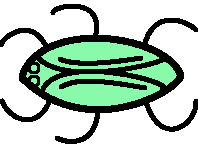Axayacatl (insect)
Axayacatl refers to the aquatic larvae of the Aeshnidae family, commonly known as dragonfly nymphs. These insects are a significant part of the freshwater ecosystems, playing a crucial role in the aquatic food chain. The term "Axayacatl" is of Nahuatl origin, used by the Aztec civilization to describe various aquatic creatures, including these larvae, which were also a source of protein in their diet.
Description[edit | edit source]
The Aeshnidae family larvae, or Axayacatl, are characterized by their elongated bodies, which can vary in color from green to brown, helping them camouflage in their natural environment. They possess a unique lower lip, known as a labium, which is extended forward to catch prey. This adaptation makes them formidable predators in their aquatic habitats. The larvae undergo several stages of growth, known as instars, during which they molt multiple times before emerging as adult dragonflies.
Habitat[edit | edit source]
Axayacatl thrive in a variety of freshwater habitats including ponds, lakes, and slow-moving rivers. They prefer environments with abundant vegetation, which provides them with cover to ambush prey and also serves as a suitable location for adult dragonflies to lay their eggs. The quality of the water and the availability of food sources play a significant role in their distribution and abundance.
Diet[edit | edit source]
The diet of Axayacatl primarily consists of other aquatic invertebrates, such as mosquito larvae, small fish, and tadpoles. Their predatory nature helps control the populations of these species, contributing to the ecological balance within their habitats.
Cultural Significance[edit | edit source]
In Aztec culture, Axayacatl were not only recognized for their role in the ecosystem but also valued as a food source. They were collected, dried, and consumed, providing a rich source of protein. This practice highlights the sustainable use of natural resources by the Aztecs and their deep understanding of the environment.
Conservation[edit | edit source]
While not specifically targeted for conservation, the habitats of Axayacatl are under threat from pollution, habitat destruction, and climate change. Protecting these environments is crucial for the preservation of Axayacatl populations and the overall health of freshwater ecosystems.
See Also[edit | edit source]
Search WikiMD
Ad.Tired of being Overweight? Try W8MD's physician weight loss program.
Semaglutide (Ozempic / Wegovy and Tirzepatide (Mounjaro / Zepbound) available.
Advertise on WikiMD
|
WikiMD's Wellness Encyclopedia |
| Let Food Be Thy Medicine Medicine Thy Food - Hippocrates |
Translate this page: - East Asian
中文,
日本,
한국어,
South Asian
हिन्दी,
தமிழ்,
తెలుగు,
Urdu,
ಕನ್ನಡ,
Southeast Asian
Indonesian,
Vietnamese,
Thai,
မြန်မာဘာသာ,
বাংলা
European
español,
Deutsch,
français,
Greek,
português do Brasil,
polski,
română,
русский,
Nederlands,
norsk,
svenska,
suomi,
Italian
Middle Eastern & African
عربى,
Turkish,
Persian,
Hebrew,
Afrikaans,
isiZulu,
Kiswahili,
Other
Bulgarian,
Hungarian,
Czech,
Swedish,
മലയാളം,
मराठी,
ਪੰਜਾਬੀ,
ગુજરાતી,
Portuguese,
Ukrainian
Medical Disclaimer: WikiMD is not a substitute for professional medical advice. The information on WikiMD is provided as an information resource only, may be incorrect, outdated or misleading, and is not to be used or relied on for any diagnostic or treatment purposes. Please consult your health care provider before making any healthcare decisions or for guidance about a specific medical condition. WikiMD expressly disclaims responsibility, and shall have no liability, for any damages, loss, injury, or liability whatsoever suffered as a result of your reliance on the information contained in this site. By visiting this site you agree to the foregoing terms and conditions, which may from time to time be changed or supplemented by WikiMD. If you do not agree to the foregoing terms and conditions, you should not enter or use this site. See full disclaimer.
Credits:Most images are courtesy of Wikimedia commons, and templates Wikipedia, licensed under CC BY SA or similar.
Contributors: Prab R. Tumpati, MD

